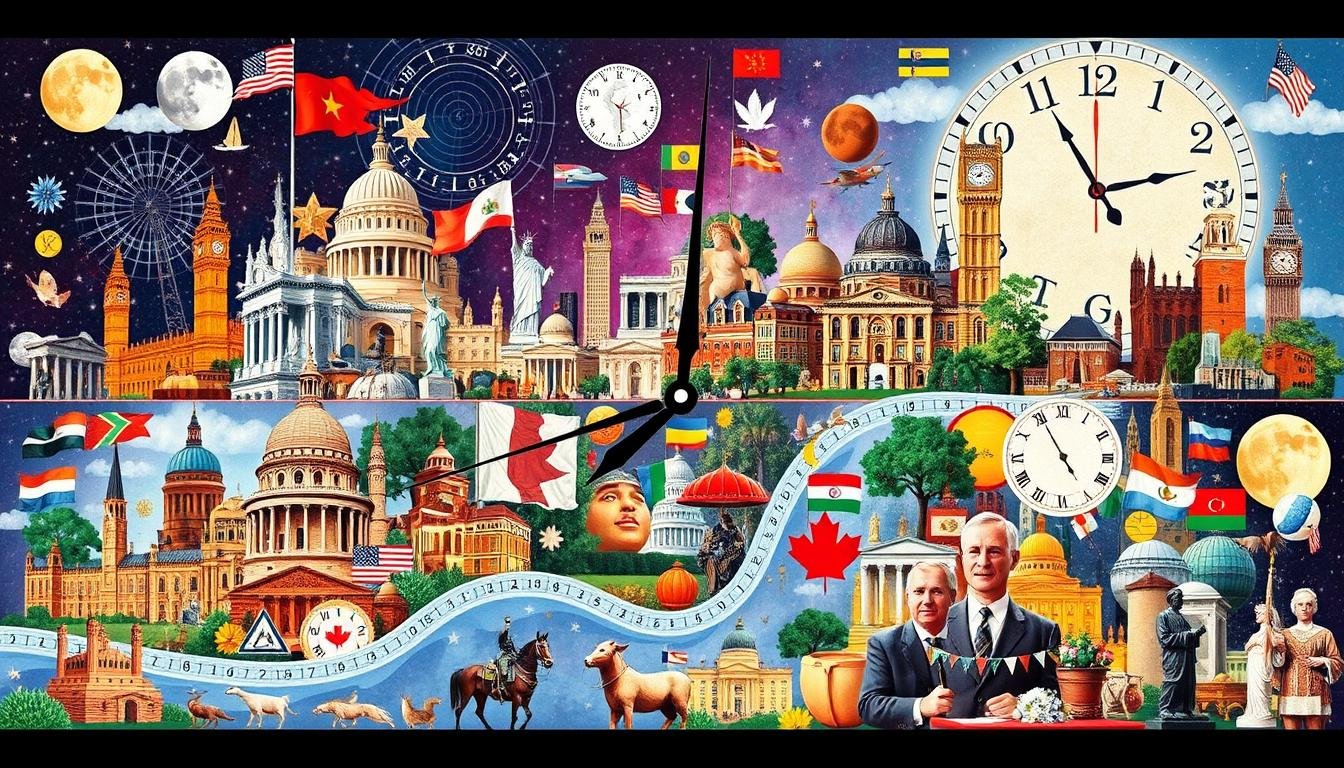This visually striking calendar layout features an array of colourful date blocks arranged in a harmonious grid. Vibrant seasonal motifs illustrate the passage of time, complemented by natural elements like leaves and flowers representing different months. The layout is placed against a soft, gradient background that evokes the feeling of the current year.
Knowing the current date helps us stay connected with the world. Each year brings new chances and challenges that shape our lives.
A calendar guide helps track events and plan schedules. The current year is key for growth and understanding.
Different cultures use varied calendar systems. This makes time tracking both complex and interesting.
The Gregorian calendar is used globally. Other cultural calendars offer insights into human society.
Technology has made tracking dates easy. Smartphones and computers show real-time information instantly.
Smart calendar apps work across many devices. They keep users in sync with their plans.
Being aware of the current year helps us adapt. It prepares us to seize new opportunities as they arise.
Understanding the Current Year
Knowing the current year is vital in our digital world. It helps us succeed in both work and personal life.
Our devices give us the date right away. Smartphones, computers, and smartwatches update on their own.
Online tools like world clocks show real-time info. Digital calendars make time management easy.
Some people like using paper calendars. Wall calendars and planners help them see the year.
Businesses need to know the exact date. It helps with meetings, planning, and setting goals.
Knowing the date is helpful in our personal lives, too. It helps us plan appointments and vacations.
Both tech and old-school tools keep us organized. They help us stay on top of our busy lives.
Calendar Types and Their Structures
Calendars help track time in different cultures. The Gregorian calendar is the most used system worldwide.
Pope Gregory XIII created it in 1582. It replaced the Julian calendar for international communication.
Lunar calendars use moon phases to measure time. Their months have different lengths.
Many Asian cultures use lunar calendars. These are important for cultural and religious events.
Solar calendars, like the Gregorian, track Earth’s rotation around the sun. They usually have 365 days.
Every four years, they add an extra day. This keeps the calendar accurate with astronomical events.
Different cultures have their solar calendars—these track seasonal changes in unique ways.
The Gregorian calendar is used globally. However, lunar and solar calendars are still crucial to many communities.
Current Events in [Current Year]
2024 has seen significant changes around the world. New tech, politics, and culture are changing how we live.
AI is changing many jobs. It helps doctors, climate experts, and city planners do better work.
Space travel has made significant steps. Countries are working together to learn more about space.
Countries are teaming up to fight climate change. They’re making plans to protect our planet.
Green energy is growing fast. This shows a significant change in how we care for Earth.
People from all over the world share their cultures online. This helps us understand each other better.
New tech is changing how we do business. AI and eco-friendly ideas are creating new jobs.
Historical Context of the Current Year
This vibrant collage depicts various historical anniversaries and commemorations throughout the years. It features iconic landmarks, significant symbols, and cultural artefacts representing diverse historical events. The collage is intertwined with a flowing timeline that visually connects each moment, set against a backdrop of a dynamic clock face showcasing the passage of time.
Every year brings a unique mix of historical events. These connect our present to important past moments.
Commemorations help us understand how history shapes our world today. They give us insights into our shared human experience.
Some anniversaries are extra special. They mark significant political changes or scientific discoveries.
Historians use these moments to examine past events again and study how they still affect us today.
Museums and schools often create special shows for these anniversaries. These help keep historical knowledge alive.
They also get people interested in stories that shaped our world. By looking at history, we see how it affects us today.
History isn’t just a list of dates. It’s a living story that keeps inspiring us.
Recognizing Leap Years
Leap years keep our calendar accurate. They happen every four years, adding a day to February.
Years divisible by 4 are usually leap years. Century years must be divisible by 400 to qualify.
The Earth takes about 365.242 days to orbit the sun. Leap years stop our calendar from drifting away from the solar year.
People born on February 29 are called “leaplings.” In non-leap years, they celebrate on February 28 or March 1.
The Gregorian calendar is used worldwide for leap year calculations. It’s the most common system for fixing time issues.
Cultural Significance of the Year
Cultural celebrations link communities and keep traditions alive. Societies mark time through unique New Year customs that reflect their heritage.
These yearly customs offer insights into diverse ways people celebrate important moments. They represent spiritual renewal, community bonding, and personal reflection.
Some cultures perform elaborate rituals for the new year. Others focus on simple family gatherings.
Global communities welcome each year in distinctive ways. Vibrant street festivals and intimate family ceremonies show the importance of cultural connections.
Through these yearly customs, young people learn about their heritage, ensuring that cherished practices continue for generations to come.
Understanding different celebrations helps people appreciate the world’s diverse human experiences. Music, dance, food, and special ceremonies showcase unique cultural perspectives.
Planning Your Year Wisely
Precise goal setting is key to effective yearly planning. It can transform potential into real success.
Create a roadmap that links your dreams to doable actions. Break big goals into smaller steps.
Pick three to five main goals for your year. Make sure they cover work, growth, health, and relationships.
Track your progress using digital tools or paper planners. For best results, mix tech support with personal commitment.
Good time management is crucial for yearly plans. Use methods like the Eisenhower Matrix to sort tasks.
Check and update your plans every few months. Be ready to change course if needed.
Looking Ahead: The Future Years
The future requires smart planning and strategic thinking. We’re entering a new era in which technology will change how we work and communicate.
Long-term planning is key in this fast-changing world. It helps us adapt to new challenges and grab opportunities.
Big changes are coming in many areas. AI will bring new tech advances, and the global economy may shift dramatically.
We need to be ready for these changes. Developing flexible skills and staying open-minded is crucial.
Planning isn’t about predicting everything. It’s about making firm plans that can handle surprises.
We can grow by understanding current trends. This helps us build good frameworks for success.
Looking ahead means constantly learning and adapting. Staying informed helps us make wise choices in a complex world.
FAQ
How can I quickly determine the current year?
Check your phone, computer, or wall calendar for the current year. Most devices update the date automatically, making it easy to stay informed.
What is the Gregorian calendar, and why is it widely used?
The Gregorian calendar is the most common civil calendar worldwide. It was introduced in 1582 to improve the Julian calendar.
This system tracks days, months, and years more accurately. Most countries use it for civil and official purposes.
What makes a leap year different?
Leap years happen every four years, adding February 29 to the calendar. This keeps the calendar year in sync with Earth’s orbit around the sun.
Years divisible by 4 are usually leap years. Century years must be divisible by 400 to qualify.
How do different cultures track years?
Many cultures use different calendar systems besides the Gregorian calendar. The Chinese calendar is based on lunar cycles.
The Islamic calendar is purely lunar. Hebrew and Buddhist traditions have their unique year-counting methods.
Why is it important to keep track of the current year?
Knowing the current year helps with planning and understanding the historical context. It’s helpful in scheduling events, managing finances, and staying connected with global happenings.
How can I set practical goals for the current year?
Think about what you achieved last year. Set clear, measurable goals and break them into small steps.
Use planners to track your progress. Be ready to adjust your plans as needed.
Are there any unique ways to remember the current year?
Create memorable links between the year and essential events in your life. Use rhymes or sayings to help you remember the number.
Try using yearly planners or goal-tracking apps on your phone. Make visual reminders to remember the year.
How do digital devices keep track of the year?
Digital devices use internal clocks with battery backup—these sync with internet time servers to stay accurate.
They update automatically for time zones, daylight saving, and leap years. This ensures correct time tracking.
you may also read : Understand Your Edad: A Guide to Age in Spanish Culture



